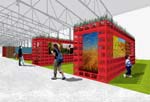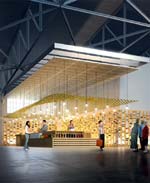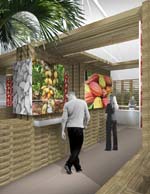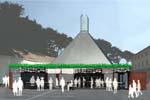
|

|
|
Home Site Search Contact Us Subscribe
|
|
|
Design by the Bushel: San Francisco design firms work fast to bring Slow Food Nation ′08 to the city′s front door, August 29 to September 1 By ArchNewsNow August 25, 2008 Anyone planning to attend San Francisco’s 5th Annual Architecture and the City Festival (September 1-30) might want to head to the City by the Bay a few days early for the inaugural U.S. edition of the Slow Food Nation ′08: Come to the Table celebration, taking place over Labor Day weekend, August 29 to September 1. Over the past four months, leading Bay Area architecture and design firms have stepped up to the plate in pro bono collaborations with Slow Food Nation curators to create some very tasty venues at the Civic Center and Fort Mason Center. The projects include everything from interactive Taste exhibits, a Marketplace, and a Soapbox, to the installation of a 10,000-sqaure foot organic Victory Garden in the plaza in front of City Hall (planting started in July).
Addressing issues of sustainability, reuse, and repurpose, designers have worked within very limited budgets to construct spaces that will create as little post-event waste as possible.
Design firms participating include: Aidlin Darling Design; David Baker + Partners Architects; Baldauf Catton von Eckartsberg (BCV) Architects; Cary Bernstein Architect; CCS Architecture; CMG Landscape Architecture; envelope Architecture+Design; Marta Fry Landscape Associates; IDEO; J+DForm; Jensen Architects; Macy Architecture; Min|Day; Public Architecture; Randolph Designs; ROMA Design Group; Sagan Piechota Architecture; Stanley Saitowitz | Natoma Architects; Second Office; Skidmore, Owings & Merrill (SOM); SMWM; Studio Terpeluk; and Winslow Architecture.
Here’s a sampling of who’s done what at both locations:
Fort Mason Center Fort Mason Master Plan – Baldauf Catton von Eckartsberg Architects Fort Mason Outdoor Space Plan – ROMA Design Group
The Taste Pavilions are Slow Food Nation’s grand celebration of good, clean, and fair food from across the United States. Taking place in the 50,000-square-foot Festival Pavilion at Fort Mason Center, each of the 15 uniquely designed pavilions showcases a different food through on-site demonstrations and tastings. Featured foods include: Beer, Bread, Charcuterie, Cheese, Chocolate, Coffee, Fish, Honey & Preserves, Ice Cream, Native Foods, Olive Oil, Pickles & Chutney, Spirits, Tea, and Wine.
Beer – Randolph Designs Paired with Beer Curator Dave McLean, John Randolph has repurposed refrigerated shipping containers to chill and store the 150 microbrews being served via bottle, cask, and keg, and to provide enclosure in an otherwise windy outdoor location at Fort Mason. The bar, made of recycled beer bottles, will be topped by a loaned Vetrazzo “Alehouse Amber” recycled countertop.
Bread – Stanley Saitowitz | Natoma Architects Creating the entryway to the Taste Pavilion and constructed out of a complex scaffolding system, the Bread Pavilion will houses both a baking area and a “Bread Museum.” Acme Bread’s Steve Sullivan and Natoma Architects have designed a display space large enough to showcase breads from more than 40 bakeries across the country and nearly 200 photographs. Other key elements include a living wheatgrass planter box and service and preparation counters in the French bakery tradition.
Charcuterie – Cary Bernstein Architect Cary Bernstein Architect’s design reinterprets the familiar butcher shop in the form of a gallery. Using large-scale photographs of salumi, video installations (including a “Salumipedia”), object vitrines, and display of the cultural history of meat eating shown through significant artworks, the Charcuterie Pavilion also features more than 200 samples of charcuterie displayed in large-scale “meatrines” and traditional tools used in charcuterie production.
Cheese – Macy Architecture Drawing inspiration from materials used in cheese production, Macy Architecture sourced more than 1,100 milk crates to create the structural element for the Cheese Pavilion. Sprouting atop the crate structure, several grass varietals illustrate the importance of the animals’ diet, while an “aging cave” constructed of hay bales will explain affinage, the craft of aging and maturing cheese. After the event, all of the milk crates will be returned to Straus Family Creamery.
Chocolate – Aidlin Darling Design For the multi-sensory environment that is equal parts education and tasting, Aidlin Darling Design’s Chocolate Pavilion is an aggregation of hundreds of borrowed shipping pallets that transform this ubiquitous industrial object into an artful frame through which the story of chocolate is told. The visitor can talk with the farmers, see material that shares cacao’s origins, hear the crack of cocoa shells, and smell the aroma and taste the chocolate as it’s being made by artisan chocolate-makers.
Coffee & Tea – envelope Architecture+Design The Coffee and Tea Pavilions are conceived as filters for experience. Sheer fabric-enclosed Tea Pods and Coffee Halls remove the visitor from the activity of the larger event. These tasting chambers offer a more intimate experience and allow visitors to focus on the cup in their hand, the nuances of the brew, and discussions with an expert. The pavilion design is framed by an ethic of reuse: all elements are either rented, readily available items, or will be repurposed after the event.
Fish – Marta Fry Landscape Associates Working with a space spanning over 3,000 square feet, Marta Fry Landscape Associates and Fish Curator Tom Worthington have designed an educational exhibit and tasting area inspired by the continual motion of tidal flows. Visitors are “lured” into the space to explore each of the pavilion’s educational themes: environment, salmon, best practice fishing, and an art exhibit. Other features include the tasting area and a “bellavista” displaying the day’s catch on ice.
Honey and Preserves – Second Office Inspired by the idea that honey and jam are “backyard foods” that can be produced using ingredients found in a San Francisco yard, the main wall of the pavilion is a backyard fence that one can peek through. The Second Office team used primarily borrowed materials such as berry crates that will go back into use after the event; the pavilion also features observation hives and a pollinator garden.
Ice Cream – J+DForm Using simple wooden crates stacked and overflowing with the fruits of the season, J+DForm has incorporated design elements inspired by the ingredients that produce quality gelato and ice cream. A panoramic view of a snow-capped mountain is the background for display and tasting counters – also designed and constructed out of re-purposed wooden crates.
Native Foods – John Glavis, Bernadette Zambrano and Diana Almeadariz Located outdoors at Fort Mason Center, the Native Foods pavilion features three traditional Native American Yokut shelters and two ramada shade structures constructed out of bundles of native California tule reeds. The tule is being collected in the Sacramento Valley, woven into mats by volunteers at the Regenerative Design Institute in Bolinas, California, and are being assembled into the Yokut huts and ramadas onsite.
Olive Oil – Brett Terpeluk, Studio Terpeluk Dual enclosures, split by a band of olive trees, give visitors the choice of cursory or in-depth olive oil tastings. The cursory tasting area offers a more sensual experience where the visitor samples regional oils on a 20-foot-long reclaimed wood table ringed by a continuous band of subtly-lit olive oil bottles. The enclosure is draped in orange olive harvesting netting punctuated by the sounds of oil in motion. The in-depth tasting area is a more educational experience where themes of regionality, history, and quality assessment are graphically described. A continuous shelf of regional oil bottles enclose a series of reclaimed wood tables where experienced tasters explain the myriad flavors of California olive oil.
Pickles & Chutney – Sagan Piechota Architecture The Pickles & Chutney Pavilion exploits the constituent elements typically associated with the process of pickling. The design includes more than 3,000 mason jar lids suspended from the ceiling, and walls made from mason jars and filled with recipes and pictures of pickles from around the world. The pavilion also includes a tasting and display area for sampling a variety of pickles from across the nation.
Spirits – Min|Day The Spirits Pavilion is an abstract field of colored strips reminiscent of agricultural planting beneath a floating cloud of colored paper umbrellas. The environment evokes the agricultural origins of spirits – surplus grains and produce transformed into something magical. Backing this abstracted space is a long wooden bar clad in historical images of bars, public houses, and cocktail lounges that gave birth to the American cocktail.
Wine – David Winslow, Winslow Architecture The largest space of the indoor Taste Pavilions and housing wines from across the nation, the Wine Pavilion features a 36-foot-long bar and five tasting tables staffed by professional sommeliers. In addition, large info-graphic panels focusing on sustainable wine production and practices, photography from American vineyards, and iconic wooden wine barrels showcase the best of American wines.
Civic Center Civic Center Master Plan - SMWM
The Civic Center houses the Slow Food Nation Victory Garden, the Marketplace, featuring 60 California farmers, and Slow on the Go, an outdoor food bazaar demonstrating how “fast” Slow Food can be.
Compost Exhibit – IDEO Constructed out of reclaimed wooden shipping pallets, the Compost Exhibit is an educational, hands-on space to learn about the composting process. The “kitchen sink” display offers information and facts about composting at home, and a working compost pile provides an opportunity to see compost in action. Visitors can take home ready-to-plant “black gold” compost bricks.
Food Bill Declaration – Public Architecture Working with Roots of Change to provide a forum in the Rotunda of City Hall for the ceremonial launch of a petition calling for New Vision for a 21st Century Food, Farm & Agricultural Policy, Public Architecture has paired a customary speakers podium with a display of locally grown fruits and vegetables, evoking a literal representation of farm policy.
Slow on the Go – CCS Architecture, David Baker + Partners Architects Drawing inspiration from open air markets in Marrakech, Morocco, David Baker + Partners and CCS Architecture have teamed up to design the outdoor food vendor stalls and eating area at Civic Center Plaza. An “infinite” table and canopy runs the length of the Slow on the Go area; the table is the front counter for each vendor kitchen and a community table for sharing and socializing under the shade of the canopy. The table top is made from rough cut eucalyptus trees set on rented scaffolding; post event, the wood will be returned to be milled into lumber and the scaffolding returned to its owner.
Soap Box – Craig Hartman, Skidmore, Owings & Merrill Located in the Slow Food Nation Victory Garden and already fully constructed, the Soap Box was originally designed as a temporary space for farmers and food producers to share stories and information among a small audience. However, to suit the longer term needs of the Victory Garden, SOM adapted the design by adding storage space in the stage for garden tools. Working with Scene 2 Construction, the structure was erected in time for the Victory Garden Community Planting Day on July 12, 2008. Recycled lumber was donated by The Reuse People in Oakland.
Water Stations – SMWM Working with Food & Water Watch to create a space to serve San Francisco municipal tap water to Slow Food Nation attendees, SMWM’s design juxtaposes large-scale images of the Hetch Hetchy Reservoir with a structure built of recycled water bottles.
Welcome Pavilions – Jensen Architects The Welcome Pavilions at Fort Mason and Civic Center Plaza serve as a beacon and a billboard Each is housed in a re-claimed shipping container painted in Slow Food Nation signature orange and topped by a full-size, galvanized-steel windmill. The shipping container design also provides the necessary security.
Design Advisory Committee: Hans Baldauf, BCV Architects; Allison Arieff, New York Times, Sunset Magazine; Michael Bernard, Virtual Practice; John Peterson, Public Architecture and Peterson Architecture; John Bela, CMG Landscape Architecture; Larry Bain, Let’s Be Frank; Michelle Meany, Wilson Meany Sullivan; Eleanor Bertino, Eleanor Bertino PR; and Margie O’Driscoll, Executive Director, AIA San Francisco.
Slow Food Nation is a subsidiary non-profit of Slow Food USA and part of the international Slow Food movement. It was created to organize the first-ever American collaborative gathering to unite the growing sustainable food movement and introduce thousands of people to food that is good, clean, and fair through enjoyable and educational activities. Slow Food Nation is dedicated to creating a framework for a deeper environmental connection to our food, and aims to inspire and empower Americans to build a food system that is sustainable, healthy, and delicious. |
(click on pictures to enlarge)  Jensen Architects: Slow Food Nation Welcome Pavilion at the Civic Center  Macy Architecture: Cheese Pavilion  envelope Architecture+Design: Coffee & Tea Pavilion  Stanley Saitowitz | Natoma Architects: Bread Pavilion  Sagan Piechota Architecture: Pickles & Chutney Pavilion  Aidlin Darling Design: Chocolate Pavilion  Marta Fry Landscape Associates: Fish Pavilion  Cary Bernstein Architect: Charcuterie  Randolph Designs: Beer Pavilion  Slow Food Nation ‘08 |
© 2008 ArchNewsNow.com